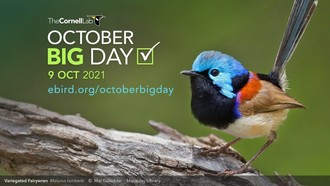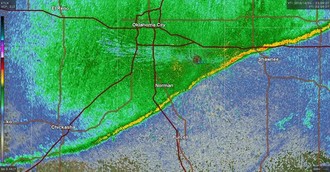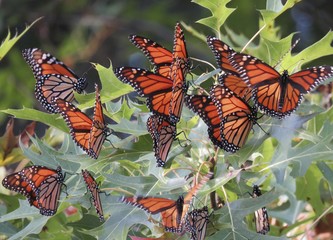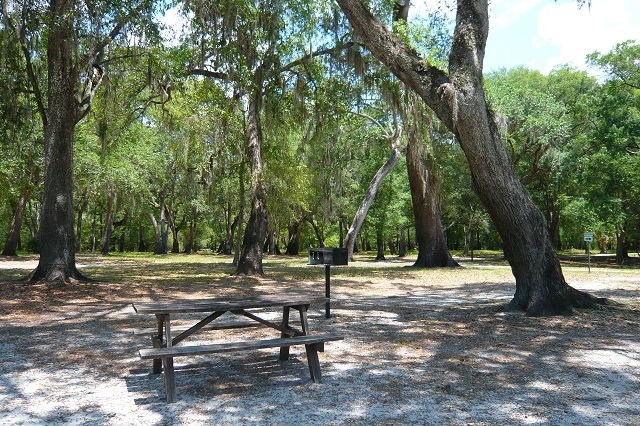
Fall is here, which means we can look forward to cooler weather, peak migration and - of course - the October Big Day on October 9th!
Global big days are celebrated twice a year, in spring and fall, and aim to mobilize birders to get out and record as many species as they can. In addition to being a fun way to engage with the birding community, reporting your findings in eBird helps create a detailed snapshot of bird populations taken at the same time every year and provides valuable data for scientists and conservation managers.
Last year’s fall big day saw more than 32,000 participants submitting 80,400 checklists with 7,128 species – will you join the effort to help the birding community beat its old record?
You can find more tips and information on the eBird website. We wish good luck and happy birding to all participants!
 Radar can show migrating monarch butterflies, as in this image from the National Weather Service.
Last fall, we shared that radar isn’t just good for tracking weather patterns – it also helps us track migrating birds.
Radar is short for “radio detection and ranging,” and works by emitting an electromagnetic pulse from a radar unit, which bounces off of a target, and then bounces back to the unit. Most of us are familiar with weather radar maps, but it comes as a surprise to many that precipitation isn’t the only thing that can be picked up. Detectable targets include everything from aircraft to smoke particles to – yes – migrating animals! Technological advancements in radar devices and computing power have made it easier to distinguish bird activity from that of other targets, and to quickly process that information so it can be used to predict migratory activity, which is perfect for figuring out when it’s worthwhile to get up at the crack of dawn to check out your favorite migratory hotspots.
But birds aren’t the only animals to be detected this way. As monarchs are migrating south, they have also been spotted on radar!
 During migration, monarch butterflies will often spend the night in communal roosting sites. USFWS Photo.
Each fall, as temperatures drop in the United States and Canada, monarch butterflies complete a migration south to the mountains of Mexico, with some individuals traveling up to 3,000 miles. The butterflies travel by daylight and roost in large congregations at night. Incredibly, the monarchs making this journey have never been to Mexico before, as it takes multiple generations to make the journey north each spring. Researchers have found that the insects use a combination of cues including the earth’s magnetic field and the position of the sun to aid in navigation.
Unfortunately, monarch populations have been in steep decline in recent years due to loss of habitat and the use of herbicides that kill milkweed, the plant on which these butterflies lay their eggs. The good news? You can help monarchs when they return in spring simply by adding beautiful flowers to your garden. Of the 21 native milkweed species, there are several that grow well in yards and containers. Be sure to source your milkweed from retailers, such as native plant nurseries, to ensure there are no insecticides that could harm monarch caterpillars. With your help, we can make strides to protect these beautiful butterflies.

6470 SW 80th Ave., Trenton, 32693
Open: Daily, 8:30 a.m. to sunset
Contact: 352-463-0800, ottersprings.com
Near the entrance, stop at the park office to obtain a map and bird checklist, and to pay the entrance fee. Otter Springs is a second-magnitude spring and is popular with swimmers and paddlers but during less busy times you might encounter Limpkins and other wading birds. Look skyward for Mississippi and Swallow-tailed Kite; Red-shouldered and Red-tailed Hawk are possible, too. Rental kayaks and a launch are available at the head of the spring run. The park has more than five miles of well-marked, well-maintained multi-use trails, from which you can explore a variety of habitats, such as bottomland and floodplain forest, swamp, upland mixed forest, pine flatwoods and sandhills. Typically, the trails are lightly traveled. Take the 1-mile Little Otter Trail down to Little Otter Spring and the Suwannee River; along the way, watch and listen for breeding birds, such as Barred Owl, Pileated Woodpecker and Prothonotary Warbler. Check the Palmetto Loop Trail and the Sandhill Trail loop for Wild Turkey and gopher tortoise. A southerly spur off the Sandhill Trail lets you check the large field along the entrance road for winter sparrows, as well as American Kestrel, Eastern Bluebird and Loggerhead Shrike. This very family-friendly park has cabins and numerous camping options available.

Saturday, October 2
Field Trip: Camp Blanding Wildlife Management Area (Starke)
Scrub-Jay Trail Orientation (Clermont)
Hawk Watch at Merritt Island National Wildlife Refuge
Sunday, October 3
Wekiwa Springs State Park Monthly Bird Survey (Apopka)
Birding 101 at Reddie Point Preserve (Jacksonville)
Birding 101 Walk (St. Augustine)
Wednesday, October 6
Nature/Bird Walk (Silver Springs)
Thursday, October 7
Thursday Morning at Matanzas Inlet with Peggy Cook (St. Augustine)
An Evening with Clyde Butcher and Nathaniel Reed (Port St. Lucie)
Saturday, October 9
Field Trip: Jacksonville Arboretum and Gardens
October Big Day (Ocala)
Fall Beginners’ Bird Watching Class (Christmas)
Wednesday, October 13
SJCA Monthly Meeting: Identifying Raptors in Florida (Virtual)
Friday, October 15 – 17
Florida Birding Nature Festival (Apollo Beach)
Saturday, October 16
Birding the GTM NERR (Ponte Vedra Beach)
Nature Walk and Work Day at Crosby Sanctuary (Orange Park)
Backyard Biodiversity Nature Day and Native Plant Sale (Winter Park)
Landscaping with Florida Native Tour
Sunday, October 17
Limited Edition Field Trip to Ferndale Nature Preserve and Green Mountain Overlook (Minneola)
Monday, October 18
Monthly Program: Light Pollution and Birds (Virtual)
Thursday, October 21
Bird Walk: Princess Place Preserve (Palm Coast)
Nature/Bird Walk (Dunnellon)
Saturday, October 23
Open House at Crosby Sanctuary (Orange Park)
Field Trip to the Lake Apopka Wildlife Drive (Apopka)
Tuesday, October 26
Rock Springs Reserve Quarterly Bird Survey (Sorrento)
Saturday, October 30
Field Trip: Hugenot Memorial Park (Jacksonville)
Do you know about any other bird or wildlife-related events going on in Florida? Help spread the word by letting us know! Send in the times, dates, locations and contacts to WildlifeViewing@MyFWC.com for posting on the Great Florida Birding and Wildlife Trail website.
Events must be related to birds or other wildlife and must be open to the public. Examples include field trips, interpretive programming, webinars, summer camps and family programs.
|